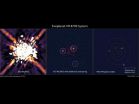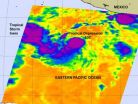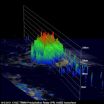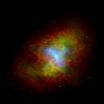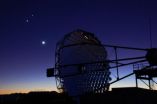(Press-News.org) In a painstaking re-analysis of Hubble Space Telescope images from 1998, astronomers have found visual evidence for two extrasolar planets that went undetected back then.
Finding these hidden gems in the Hubble archive gives astronomers an invaluable time machine for comparing much earlier planet orbital motion data to more recent observations. It also demonstrates a novel approach for planet hunting in archival Hubble data.
Four giant planets are known to orbit the young, massive star HR 8799, which is130 light-years away. In 2007 and 2008 the first three planets were discovered in near-infrared ground-based images taken with the W.M. Keck Observatory and the Gemini North telescope by Christian Marois of the National Research Council in Canada and his team. Marois and his colleagues then uncovered a fourth innermost planet in 2010. This is the only multiple exoplanetary system for which astronomers have obtained direct snapshots.
In 2009 David Lafreniere of the University of Montreal recovered hidden exoplanet data in Hubble images of HR 8799 taken in 1998 with the Near Infrared Camera and Multi-Object Spectrometer (NICMOS). He identified the position of the outermost planet known to orbit the star. This first demonstrated the power of a new data-processing technique for retrieving faint planets buried in the glow of the central star.
A new analysis of the same archival NICMOS data by Remi Soummer of the Space Telescope Science Institute in Baltimore has recovered all three of the outer planets. The fourth, innermost planet is 1.5 billion miles from the star and cannot be seen because it is on the edge of the NICMOS coronagraphic spot that blocks the light from the central star.
By finding the planets in multiple images spaced over years of time, the orbits of the planets can be tracked. Knowing the orbits is critical to understanding the behavior of multiple-planet systems because massive planets can perturb each other's orbits. "From the Hubble images we can determine the shape of their orbits, which brings insight into the system stability, planet masses and eccentricities, and also the inclination of the system," says Soummer.
These results are to be published in the Astrophysical Journal.
The three outer gas-giant planets have approximately 100-, 200-, and 400-year orbits. This means that astronomers need to wait a very long time to see how the planets move along their paths. The added time span from the Hubble data helps enormously. "The archive got us 10 years of science right now," he says. "Without this data we would have had to wait another decade. It's 10 years of science for free."
Nevertheless, the slowest-moving, outermost planet has barely changed position in 10 years. "But if we go to the next inner planet we see a little bit of an orbit, and the third inner planet we actually see a lot of motion," says Soummer.
The planets weren't found in 1998 when the Hubble observations were first taken because the methods used to detect them were not available at that time. When astronomers subtracted the light from the central star to look for the residual glow of planets, the residual light scatter was still overwhelming the faint planets.
Lafreniere developed a way to improve this type of analysis by using a library of reference stars to more precisely remove the "fingerprint" glow of the central star. Soummer's team took Lafreniere's method a step further and used 466 images of reference stars taken from a library containing over 10 years of NICMOS observations assembled by Glenn Schneider of the University of Arizona.
Soummer's team further increased contrast and minimized residual starlight. They completely removed the diffraction spikes, which are artifacts common to telescope imaging systems. This allowed them to see two of the faint inner planets in the Hubble data. The planets recovered in the NICMOS data are about 1/100,000th the brightness of the parent star when viewed in near-infrared light.
Soummer next plans to analyze approximately 400 other stars in the NICMOS archive with the same technique, improving image quality by a factor of 10 over the imaging methods used when the data were obtained.
Soummer's work demonstrates the power of the Hubble Space Telescope data archive, which harbors images and spectral information from over twenty years of Hubble observations. Astronomers tap into this library to complement new observations with a wealth of invaluable data already gathered, yielding much more discovery potential than new observations alone.
From the NICMOS archive data Soummer's team will assemble a list of planetary candidates to be confirmed by ground-based telescopes. If new planets are discovered they will once again have several years' worth of orbital motion to measure.
INFORMATION:
The Hubble Space Telescope is a project of international cooperation between NASA and the European Space Agency. NASA's Goddard Space Flight Center manages the telescope. The Space Telescope Science Institute (STScI) conducts Hubble science operations. STScI is operated for NASA by the Association of Universities for Research in Astronomy, Inc., in Washington, D.C.
Astronomers find elusive planets in decade-old Hubble data
2011-10-10
ELSE PRESS RELEASES FROM THIS DATE:
Researchers find race disparity in post-hospital arrival homicide deaths at trauma centers
2011-10-10
AMHERST, Mass. -- New research based on post-hospital arrival data from U.S. trauma centers finds that even after adjusting for differences in injury severity, gun use, and other likely causes of race difference in death from assault, African-Americans have a significantly higher overall post-scene of injury mortality rate than whites. The study was conducted by Anthony R. Harris, emeritus professor of sociology at the University of Massachusetts Amherst, and colleagues and published in August by the Journal of Trauma, Injury, Infection and Critical Care.
The study, ...
People without cars, financial assets less likely to marry: study
2011-10-10
A study published this week in the American Journal of Sociology finds that people who lack personal wealth in the form of a car or financial assets are significantly less likely to enter into a first marriage. The results, according to study author Daniel Schneider of Princeton University, shed light on recent changes in marriage patterns in the U.S.
For the past few decades, Americans have been getting married later in life and are becoming more likely forego marriage altogether. Between 1970 and 2000, the median age of first marriage in the U.S. rose by about four ...
NASA's Aqua satellite sees birth of two tropical cyclones in Eastern Pacific
2011-10-10
The tropics in the eastern Pacific were quiet for a couple of days after Hurricane Hilary dissipated, and today gave birth to Tropical Depression 10 and Tropical Storm Irwin. NASA's Aqua satellite captured an infrared image of both storms and saw the powerful convection in the center of Irwin that enabled the storm to go from a depression to a tropical storm in a short time.
The eleventh tropical depression quickly grew into Tropical Storm Irwin this morning, as strong convection surged around its center of circulation. That convection (rising air that creates the thunderstorms ...
A 3-D look at Philippe provided clues of transition into a hurricane
2011-10-10
Tropical Storm Philippe took its time to strengthen into a hurricane because of wind shear problems. The wind shear lessened, and Philippe became a hurricane today, after 12 days of moving across the Atlantic Ocean. NASA's TRMM satellite saw towering thunderstorms and intense rainfall within Philippe yesterday, which provided forecasters with a clue that the storm was strengthening. Philippe reached hurricane status this morning, Oct. 6, 2011.
Over two days, the Tropical Rainfall Measuring Mission (TRMM) satellite provided forecasters with cloud heights and rainfall rates ...
Astrophysicists spot pulsed radiation from Crab Nebula that wasn't supposed to be there
2011-10-10
An international collaboration of astrophysicists, including a group from the Department of Physics in Arts & Sciences at Washington University in St. Louis, has detected pulsed gamma rays from the neutron star at the heart of the Crab Nebula with energies far higher than the common theoretical models can explain.
The pulsed gamma rays had energies between 100 and 400 billion electronvolts (Gigaelectronvolts, or GeV), far higher than 25 GeV, the highest energy radiation from the neubla previously detected. A 400 GeV photon is 11 orders of magnitude – almost a trillion ...
Crab Pulsar emits light at highest energies ever detected in a pulsar system, scientists report
2011-10-10
An international team of scientists has detected the highest energy gamma rays ever observed from a pulsar, a highly magnetized and rapidly spinning neutron star.
The VERITAS experiment measured gamma rays coming from the Crab Pulsar at such large energies that they cannot be explained by current scientific models of how pulsars behave, the researchers said.
The results, published today in the journal Science, outline the first observation of photons from a pulsar system with energies greater than 100 billion electron volts -- more than 50 billion times higher than ...
Sniffing out the brain's predictive power
2011-10-10
CHICAGO --- In the moments before you "stop and smell the roses," it's likely your brain is already preparing your sensory system for that familiar floral smell. New research from Northwestern Medicine offers strong evidence that the brain uses predictive coding to generate "predictive templates" of specific smells -- setting up a mental expectation of a scent before it hits your nostrils.
Predictive coding is important because it provides animals -- in this case, humans -- with a behavioral advantage, in that they can react more quickly and more accurately to stimuli ...
Study uncovers why anti-rejection drugs for transplant patients cause hypertension
2011-10-10
PORTLAND, Ore. — Modern medicine's ability to save lives through organ transplantation has been revolutionized by the development of drugs that prevent the human body from rejecting the transplanted organ.
But those antirejection drugs have their own side effects — sometimes serious.
A group of researchers led by scientists at Oregon Health & Science University has discovered the process that may be causing many of those side effects. And the discovery means those side effects likely can be dealt with cheaply and easily — with a class of widely used drugs that are often ...
Bone marrow cells migrate to tumors and can slow their growth
2011-10-10
Philadelphia, PA, October 6, 2011 – Bone marrow-derived cells (BMDCs) participate in the growth and spread of tumors of the breast, brain, lung, and stomach. To examine the role of BMDCs, researchers developed a mouse model that could be used to track the migration of these cells while tumors formed and expanded. Their results, published in the November issue of The American Journal of Pathology, strongly suggest that more effective cancer treatments may be developed by exploiting the mechanism by which bone marrow cells migrate to tumors and retard their proliferation.
"Our ...
Raising 'good' cholesterol levels reduces heart attack and stroke risk in diabetes patients
2011-10-10
Increasing levels of high-density lipoproteins, better known as HDL or "good" cholesterol, reduced the risk for heart attack and stroke among patients with diabetes. That's according to a new study appearing online today in The American Journal of Cardiology.
The observational study, one of the largest of its kind, examined the medical records of more than 30,000 patients with diabetes and also found that patients whose HDL levels decreased had more heart attacks and strokes.
Researchers studied patients with diabetes because they are more prone to heart disease ...
